
Aargau, more formally the Canton of Aargau, is one of the 26 cantons forming the Swiss Confederation. It is composed of eleven districts and its capital is Aarau.

The canton of Bern or Berne is one of the 26 cantons forming the Swiss Confederation. Its capital city, Bern, is also the de facto capital of Switzerland. The bear is the heraldic symbol of the canton, displayed on a red-yellow background.

Lenzburg Castle is a castle located above the old part of the town of Lenzburg in the Canton of Aargau, Switzerland. It ranks among the oldest and most important of Switzerland. The castle stands on the almost circular castle hill, which rises approximately 100 m (330 ft) over the surrounding plain but is only about 250 m (820 ft) in diameter. The oldest parts of the castle date to the 11th century, when the Counts of Lenzburg built it as their seat. The castle, its historical museum and the castle hill with its Neolithic burial grounds are listed as heritage sites of national significance.

Brugg is a Swiss municipality and a town in the canton of Aargau and is the seat of the district of the same name. The town is located at the confluence of the Aare, Reuss, and Limmat, with the Aare flowing through its medieval part. It is located approximately 16 kilometers (9.9 mi) from the cantonal capital of Aarau; 28 kilometers (17 mi) from Zürich; and about 45 kilometers (28 mi) from Basel.
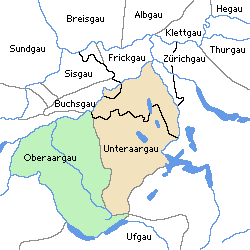
The Unteraargau is the lower watershed of the Aar River in the Swiss canton of Aargau.
The Kyburg family was a noble family of grafen (counts) in the Duchy of Swabia, a cadet line of the counts of Dillingen, who in the late 12th and early 13th centuries ruled the County of Kyburg, corresponding to much of what is now Northeastern Switzerland.

Kasteln Castle is a castle in the municipality of Oberflachs in Canton Aargau, Switzerland. It is located west of the village on a rocky outcrop, surrounded by vineyards and woods. Today, it serves as a boarding school for students with behavioral problems. The immediately adjacent castle Ruchenstein was demolished in 1643, when the small fort was rebuilt into a Schloss Kasteln.

Schenkenberg Castle is a castle ruin above the municipality of Thalheim in the canton of Aargau in Switzerland. It was built in the 13th Century by the Habsburg dynasty, was the administrative seat for 260 years of a bailiwick of the city of Bern and fell into ruin in the 18th century.

Brunegg castle is a castle in the municipality of Brunegg in the canton of Aargau in Switzerland.
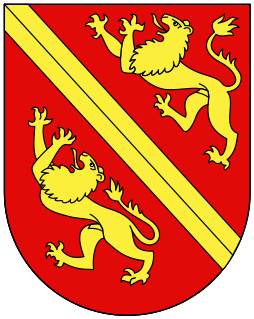
The Burgdorferkrieg or Kyburgerkrieg was a war in 1383-84 between the counts of Neu-Kyburg and the city of Bern for supremacy in the County of Burgundy in what is now Switzerland.

Burgdorf Castle is a castle in the municipality of Burgdorf in the canton of Bern in Switzerland. It is a Swiss heritage site of national significance.

Nidau Castle is a castle in the municipality of Nidau of the Canton of Bern in Switzerland. It is a Swiss heritage site of national significance.

Oberhofen Castle is a castle in the municipality of Oberhofen of the Canton of Bern in Switzerland. It is a Swiss heritage site of national significance.
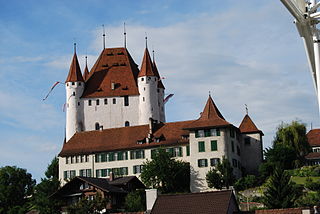
Thun Castle is a castle in the city of Thun, in the Swiss canton of Bern. It was built in the 12th century, today houses the Thun Castle museum, and is a Swiss heritage site of national significance.

The ruins of Grünenberg Castle, Schnabelburg Castle and Langenstein Castle are a complex of three interconnected castles on a hill above the municipality of Melchnau in the canton of Bern in Switzerland. The three castles formed the center of power of the Barons of Grünenberg in the Oberaargau region during the High Middle Ages.
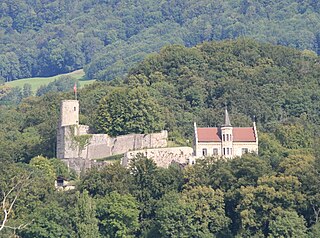
Bipp Castle is a partially ruined castle in the municipality of Oberbipp of the Canton of Bern in Switzerland.
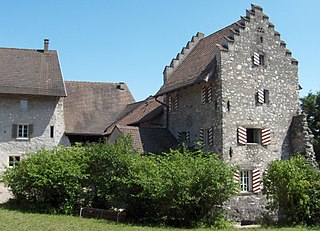
Altenburg Castle is a castle in the village of Altenburg bei Brugg in the municipality of Brugg in the canton of Aargau in Switzerland. The castle and the Altenburg Roman ruins, which are integrated into it, are classified as Swiss heritage site of national significance.
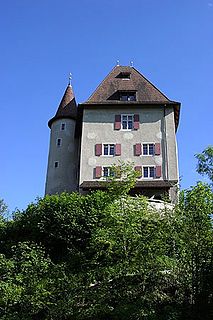
Liebegg Castle is a small castle in the municipality of Gränichen in the canton of Aargau in Switzerland. It is located on a outcropping about 70 meters (230 ft) above the Wynental valley floor. The current castle grew out of a medieval castle. A cantonal agricultural school opened in 1958 near the castle.

Weissenburg Castle is a ruined castle in the municipality of Därstetten of the Canton of Bern in Switzerland.

The Vorburg is a ruined castle located in the village of Oberurnen, now part of the municipality of Glarus Nord in the Canton of Glarus of Switzerland. It is the most significant castle in the canton.





















